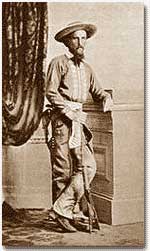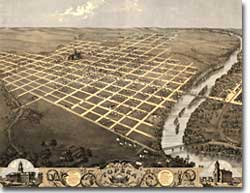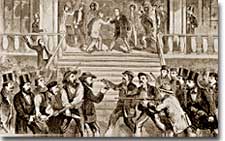31b. Border Ruffians

Border Ruffian R.H. Wilson fought against the Free Soilers in Kansas and eventually joined the Confederate Army.
The passage of the Kansas-Nebraska Act would lead to a civil war between pro-slavery and anti-slavery settlers in Kansas.
Slavery was quite likely to be outlawed in Nebraska, where cotton doesn't grow well. The situation in Kansas was entirely different, where the land was similar to Missouri's, which was a slave state. Kansas was to be governed by the principle of popular sovereignty. Whether Kansas was to be slave or free would be decided at the polls. Both free and slave forces were determined to hold sway.
Missouri counties that bordered Kansas were strongly pro-slavery and wanted their neighbor to be a slave state. In the fall of 1854, Senator David Atchison of Missouri led over 1,700 men from Missouri into Kansas to vote for their pro-slavery representative. These were the infamous "border ruffians," who threatened to shoot, burn and hang those opposed to slavery.

The city of Topeka, shown here on a panoramic map from 1869, housed the Free Soil Kansas legislature.
Although their votes were later ruled fraudulent, their candidate was elected to Congress. When it came time to elect a territorial legislature the following March, almost 5,000 men came into the state from Missouri to cast illegal ballots. Pro-slavery forces had the numbers, not the ethics, on their side. Anti-slavery settlers, though the majority in Kansas, were outvoted. The result of the election through fraud was a legislature with 36 pro-slavery delegates and 3 anti-slavery delegates.

The violence at Fort Scott, Kansas, led the governor to call for a peace convention on June 15, 1858. The meeting broke out into a riot.
As one of their first acts, this legislature passed a harsh slave code that provided fines and imprisonment simply for expressing opinions against slavery. The death penalty would be administered to any individual found guilty of assisting slaves to revolt or escape. It also legalized the "border ruffian" vote by not requiring voters to be residents in Kansas prior to voting and made the law retroactive to the preceding elections.
Within a year, the population of anti-slavery residents in Kansas far outnumbered legal residents of Kansas who were pro-slavery. They were not prepared to obey the laws of the "bogus legislature," seated in Shawnee Mission. Organized under the name of Free Soilers, they drew up a free state constitution and elected a separate governor and state legislature located in Topeka. The result was a state with two governments. Violence would soon follow.





